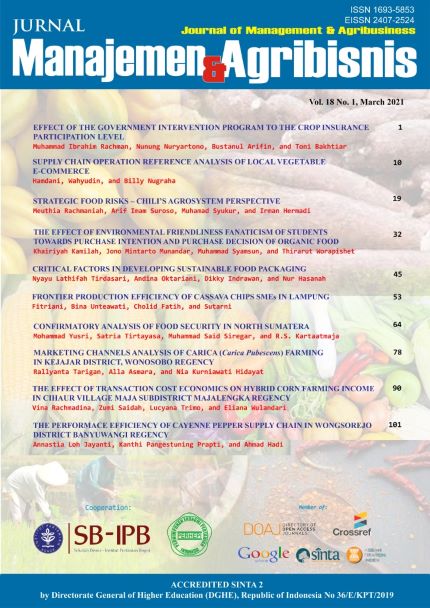THE PERFORMANCE EFFICIENCY OF CAYENNE PEPPER SUPPLY CHAIN IN WONGSOREJO DISTRICT BANYUWANGI REGENCY
Abstract
Banyuwangi Regency become one of the cayenne pepper supplier to the national market, and Wongsorejo District is the largest cayenne pepper center. The amount of supply, continuity, quality, and price of cayenne pepper in Wongsorejo District shows different values over time. This can hamper the performance of the cayenne pepper agribusiness supply chain. The purpose of this study was to map the flow of cayenne pepper supply chain, and to measure the performance of the cayenne pepper supply chain in Wongsorejo District. The research method uses descriptive-qualitative analysis to map the supply chain flow of cayenne pepper, and the Hayami added value analysis method to measure the performance of the cayenne pepper supply chain. The results showed that the supply chain of cayenne pepper in Wongsorejo District consisted of Agricultural Kiosks and the Government as suppliers; farmers as producers; collector traders, wholesalers, retailers and market traders as distributors; as well as consumers. Farmers get a value added of Rp. 5.845,83/kg, wholesaler of Rp. 12.849,48/kg, and retailers of Rp. 5.323,74/kg with a marketing margin of Rp. 18.750,83/kg. The supply chain of cayenne pepper in Wongsorejo District is classified as efficient, because the profits share is greater than the costs share.
Authors
Authors who publish with this journal agree to the following terms:
- Authors retain copyright and grant the journal right of first publication with the work simultaneously licensed under a Creative Commons Attribution License that allows others to share the work with an acknowledgement of the work's authorship and initial publication in this journal.
- Authors are able to enter into separate, additional contractual arrangements for the non-exclusive distribution of the journal's published version of the work (e.g., post it to an institutional repository or publish it in a book), with an acknowledgement of its initial publication in this journal.
- Authors are permitted and encouraged to post their work online (e.g., in institutional repositories or on their website) prior to and during the submission process, as it can lead to productive exchanges, as well as earlier and greater citation of published work (See The Effect of Open Access).

